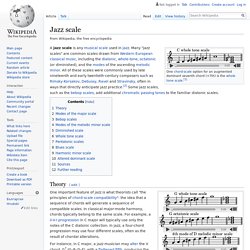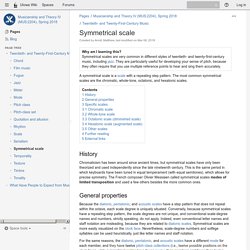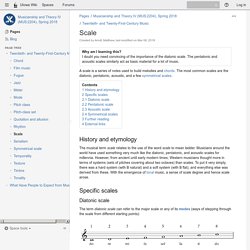

EarBeater - Free Ear Training Exercises and Music Theory App. Identify the Mode. Modes: What are they and how do I use them? 24 September 2018, 17:21 | Updated: 23 October 2019, 09:59 From their meaning to their history in Western music, here's an easy guide to modes.

The word ‘mode’ comes from the Latin for ‘manner, or method’ but musical modes all originated in ancient Greece, so they have Greek names. The modes were named after various regions, perhaps to represent the people who lived there, because Greek musical theorists were philosophers too, and associated the arts with aspects of morality.
Basically, a mode is a type of scale, as in ‘doh re mi fa so la ti do’. Alter just one of those notes and you can call your scale a ‘mode’. Long before people started thinking about pieces of music having ‘keys’, each mode is believed to have begun on a different note of the scale, conferring its own character to the set of notes running, for example, C to C (Ionian mode) or E to E (Phrygian mode) and so on.
SonicFit - Scale Identification Ear Training Exercise. This exercise plays a scale and the user identifies the scale played.

The settings allow the user to limit which scales may be played, as well as select instrument sound to be played and save scores. Before attempting this exercise, students should of course have learned the intervalic content of scales presented in the theory sequence, as well as gained proficiency in hearing steps (melodic fragments, with setting of diatonic 3) and hearing triads (interval and chord ear training with settings to triads isolating root position melodic ascending). Scales included are: Major and Minor • Major • harmonic minor • melodic minor • natural minor Modes • Ionian (Maj) • Dorian • Phrygian • Lydian • Mixolydian • Aeolian (min) • Locrian. Scale Ear Training. Teaching Modes and Exercises with Solfege « Choral Director Magazine.
Share This: Teaching the Modes with Solfège We previously discussed the method for teaching Solfège to students in elementary through high school, including a detailed run-down of the syllables, I required beginning and intermediate high school students to memorize for the following scales: MajorNatural MinorHarmonic MinorMelodic MinorChromaticWhole Tone In addition to all of the scales above, my advanced high school students were in ensembles that sang primarily early music, and were required to be able to sing and write the modes accurately:

The Exciting Universe Of Music Theory.
Scale Identification Ear Training. Lecture 5. Melody: Notes, Scales, Nuts and Bolts. Dolmetsch Online - Music Theory Online - 12 tone scales. Music theory Modes of the jazz minor scale. Jazz scale. Theory[edit] Four scales compatible with G7♭5 One important feature of jazz is what theorists call "the principles of chord-scale compatibility": the idea that a sequence of chords will generate a sequence of compatible scales.

In classical major-mode harmony, chords typically belong to the same scale. For example, a ii-V-I progression in C major will typically use only the notes of the C diatonic collection.
Category:Heptatonic scales. Gregorian mode. A Gregorian mode (or church mode) is one of the eight systems of pitch organization used in Gregorian chant.

History[edit] The name of Pope Gregory I was attached to the variety of chant that was to become the dominant variety in medieval western and central Europe (the diocese of Milan was the sole significant exception) by the Frankish cantors reworking Roman ecclesiastical song during the Carolingian period (McKinnon 2001). The theoretical framework of modes arose later to describe the tonal structure of this chant repertory, and is not necessarily applicable to the other European chant dialects (Old Roman, Mozarabic, Ambrosian, etc.).
The repertory of Western plainchant acquired its basic forms between the sixth and early ninth centuries, but there are neither theoretical sources nor notated music from this period. Tonality[edit] The eight Gregorian modes: f indicates 'final' Authentic mode[edit] Plagal mode[edit] List of musical scales and modes. Symmetrical scale - Musicianship and Theory IV (MUS:2204), Spring 2018 - UIowa Wiki. A symmetrical scale is a scale with a repeating step pattern.

The most common symmetrical scales are the chromatic, whole-tone, octatonic, and hexatonic scales. Chromaticism has been around since ancient times, but symmetrical scales have only been theorized and used independently since the late nineteenth century. This is the same period in which keyboards have been tuned in equal temperament (with equal semitones), which allows for precise symmetry. Scale - Musicianship and Theory IV (MUS:2204), Spring 2018 - UIowa Wiki.
A scale is a series of notes used to build melodies and chords.

The most common scales are the diatonic, pentatonic, acoustic, and a few symmetrical scales. The musical term scale relates to the use of the word scale to mean ladder. Musicians around the world have used something very much like the diatonic, pentatonic, and acoustic scales for millennia. However, from ancient until early modern times, Western musicians thought more in terms of systems (sets of pitches covering about two octaves) than scales. To put it very simply, there was a hard system (with B natural) and a soft system (with B flat), and everything else was derived from these.
List of musical scales and modes.